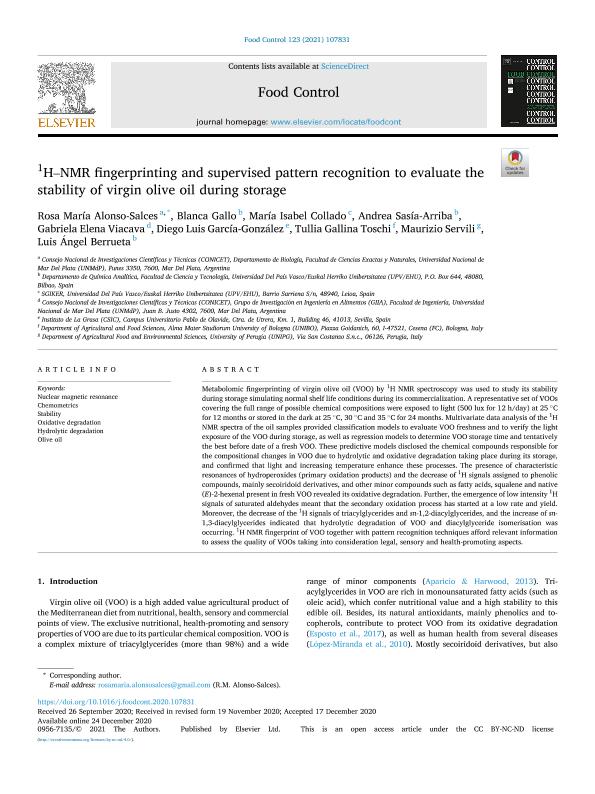Artículo
1H–NMR fingerprinting and supervised pattern recognition to evaluate the stability of virgin olive oil during storage
Alonso Salces, Rosa Maria ; Gallo, Blanca; Collado, María Isabel; Sasía Arriba, Andrea; Viacava, Gabriela Elena
; Gallo, Blanca; Collado, María Isabel; Sasía Arriba, Andrea; Viacava, Gabriela Elena ; García González, Diego Luis; Gallina Toschi, Tullia; Servili, Maurizio; Berrueta, Luis Ángel
; García González, Diego Luis; Gallina Toschi, Tullia; Servili, Maurizio; Berrueta, Luis Ángel
 ; Gallo, Blanca; Collado, María Isabel; Sasía Arriba, Andrea; Viacava, Gabriela Elena
; Gallo, Blanca; Collado, María Isabel; Sasía Arriba, Andrea; Viacava, Gabriela Elena ; García González, Diego Luis; Gallina Toschi, Tullia; Servili, Maurizio; Berrueta, Luis Ángel
; García González, Diego Luis; Gallina Toschi, Tullia; Servili, Maurizio; Berrueta, Luis Ángel
Fecha de publicación:
05/2021
Editorial:
Elsevier
Revista:
Food Control
ISSN:
0956-7135
Idioma:
Inglés
Tipo de recurso:
Artículo publicado
Clasificación temática:
Resumen
Metabolomic fingerprinting of virgin olive oil (VOO) by 1H NMR spectroscopy was used to study its stability during storage simulating normal shelf life conditions during its commercialization. A representative set of VOOs covering the full range of possible chemical compositions were exposed to light (500 lux for 12 h/day) at 25 °C for 12 months or stored in the dark at 25 °C, 30 °C and 35 °C for 24 months. Multivariate data analysis of the 1H NMR spectra of the oil samples provided classification models to evaluate VOO freshness and to verify the light exposure of the VOO during storage, as well as regression models to determine VOO storage time and tentatively the best before date of a fresh VOO. These predictive models disclosed the chemical compounds responsible for the compositional changes in VOO due to hydrolytic and oxidative degradation taking place during its storage, and confirmed that light and increasing temperature enhance these processes. The presence of characteristic resonances of hydroperoxides (primary oxidation products) and the decrease of 1H signals assigned to phenolic compounds, mainly secoiridoid derivatives, and other minor compounds such as fatty acids, squalene and native (E)-2-hexenal present in fresh VOO revealed its oxidative degradation. Further, the emergence of low intensity 1H signals of saturated aldehydes meant that the secondary oxidation process has started at a low rate and yield. Moreover, the decrease of the 1H signals of triacylglycerides and sn-1,2-diacylglycerides, and the increase of sn-1,3-diacylglycerides indicated that hydrolytic degradation of VOO and diacylglyceride isomerisation was occurring. 1H NMR fingerprint of VOO together with pattern recognition techniques afford relevant information to assess the quality of VOOs taking into consideration legal, sensory and health-promoting aspects.
Archivos asociados
Licencia
Identificadores
Colecciones
Articulos (IIPROSAM)
Articulos de INSTITUTO DE INVESTIGACIONES EN PRODUCCION, SANIDAD Y AMBIENTE
Articulos de INSTITUTO DE INVESTIGACIONES EN PRODUCCION, SANIDAD Y AMBIENTE
Articulos(CCT - MAR DEL PLATA)
Articulos de CTRO.CIENTIFICO TECNOL.CONICET - MAR DEL PLATA
Articulos de CTRO.CIENTIFICO TECNOL.CONICET - MAR DEL PLATA
Citación
Alonso Salces, Rosa Maria; Gallo, Blanca; Collado, María Isabel; Sasía Arriba, Andrea; Viacava, Gabriela Elena; et al.; 1H–NMR fingerprinting and supervised pattern recognition to evaluate the stability of virgin olive oil during storage; Elsevier; Food Control; 123; 5-2021; 1-13
Compartir
Altmétricas



